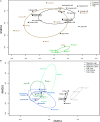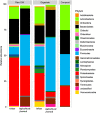Relative Weight of Organic Waste Origin on Compost and Digestate 16S rRNA Gene Bacterial Profilings and Related Functional Inferences
- PMID: 34054773
- PMCID: PMC8160089
- DOI: 10.3389/fmicb.2021.667043
Relative Weight of Organic Waste Origin on Compost and Digestate 16S rRNA Gene Bacterial Profilings and Related Functional Inferences
Abstract
Even though organic waste (OW) recycling via anaerobic digestion (AD) and composting are increasingly used, little is known about the impact of OW origin (fecal matters and food and vegetable wastes) on the end products' bacterial contents. The hypothesis of a predictable bacterial community structure in the end products according to the OW origin was tested. Nine OW treatment plants were selected to assess the genetic structure of bacterial communities found in raw OW according to their content in agricultural and urban wastes and to estimate their modifications through AD and composting. Two main bacterial community structures among raw OWs were observed and matched a differentiation according to the occurrences of urban chemical pollutants. Composting led to similar 16S rRNA gene OTU profiles whatever the OW origin. With a significant shift of about 140 genera (representing 50% of the bacteria), composting was confirmed to largely shape bacterial communities toward similar structures. The enriched taxa were found to be involved in detoxification and bioremediation activities. This process was found to be highly selective and favorable for bacterial specialists. Digestates showed that OTU profiles differentiated into two groups according to their relative content in agricultural (manure) and urban wastes (mainly activated sludge). About one third of the bacterial taxa was significantly affected by AD. In digestates of urban OW, this sorting led to an enrichment of 32 out of the 50 impacted genera, while for those produced from agricultural or mixed urban/agricultural OW (called central OW), a decay of 54 genera over 60 was observed. Bacteria from activated sludge appeared more fit for AD than those of other origins. Functional inferences showed AD enriched genera from all origins to share similar functional traits, e.g., chemoheterotrophy and fermentation, while being often taxonomically distinct. The main functional traits among the dominant genera in activated sludge supported a role in AD. Raw OW content in activated sludge was found to be a critical factor for predicting digestate bacterial contents. Composting generated highly predictable and specialized community patterns whatever the OW origin. AD and composting bacterial changes were driven by functional traits selected by physicochemical factors such as temperature and chemical pollutants.
Keywords: 16S rRNA gene meta-barcoding; anaerobic digestion; composting; functional traits; organic waste.
Copyright © 2021 Aigle, Bourgeois, Marjolet, Houot, Patureau, Doelsch, Cournoyer and Galia.
Conflict of interest statement
The authors declare that the research was conducted in the absence of any commercial or financial relationships that could be construed as a potential conflict of interest.
Figures






Similar articles
-
Occurrence of 40 sanitary indicators in French digestates derived from different anaerobic digestion processes and raw organic wastes from agricultural and urban origin.Front Microbiol. 2024 Aug 6;15:1346715. doi: 10.3389/fmicb.2024.1346715. eCollection 2024. Front Microbiol. 2024. PMID: 39165575 Free PMC article.
-
Drastic Change in Zinc Speciation during Anaerobic Digestion and Composting: Instability of Nanosized Zinc Sulfide.Environ Sci Technol. 2018 Nov 20;52(22):12987-12996. doi: 10.1021/acs.est.8b02697. Epub 2018 Oct 31. Environ Sci Technol. 2018. PMID: 30339368
-
Crop-based composting of lignocellulosic digestates: Focus on bacterial and fungal diversity.Bioresour Technol. 2019 Sep;288:121549. doi: 10.1016/j.biortech.2019.121549. Epub 2019 May 24. Bioresour Technol. 2019. PMID: 31152953
-
Upflow anaerobic sludge blanket reactor--a review.Indian J Environ Health. 2001 Apr;43(2):1-82. Indian J Environ Health. 2001. PMID: 12397675 Review.
-
A critical review of the bioavailability and impacts of heavy metals in municipal solid waste composts compared to sewage sludge.Environ Int. 2009 Jan;35(1):142-56. doi: 10.1016/j.envint.2008.06.009. Epub 2008 Aug 8. Environ Int. 2009. PMID: 18691760 Review.
Cited by
-
Occurrence of 40 sanitary indicators in French digestates derived from different anaerobic digestion processes and raw organic wastes from agricultural and urban origin.Front Microbiol. 2024 Aug 6;15:1346715. doi: 10.3389/fmicb.2024.1346715. eCollection 2024. Front Microbiol. 2024. PMID: 39165575 Free PMC article.
-
Growth of microalgae and cyanobacteria consortium in a photobioreactor treating liquid anaerobic digestate from vegetable waste.Sci Rep. 2023 Dec 19;13(1):22651. doi: 10.1038/s41598-023-50173-6. Sci Rep. 2023. PMID: 38114556 Free PMC article.
References
-
- Ahmad R., Jilani G., Arshad M., Zahir Z. A., Khalid A. (2007). Bio-conversion of organic wastes for their recycling in agriculture: an overview of perspectives and prospects. Ann. Microbiol. 57 471–479. 10.1007/BF03175343 - DOI
-
- Anukam A., Mohammadi A., Naqvi M., Granström K. (2019). A review of the chemistry of anaerobic digestion: methods of accelerating and optimizing process efficiency. Processes 7:504. 10.3390/pr7080504 - DOI
-
- Atelge M. R., Krisa D., Kumar G., Eskicioglu C., Nguyen D. D., Chang S. W., et al. (2020). Biogas production from organic waste: recent progress and perspectives. Waste Biomass Valorization 11 1019–1040. 10.1007/s12649-018-00546-0 - DOI
LinkOut - more resources
Full Text Sources
Other Literature Sources

